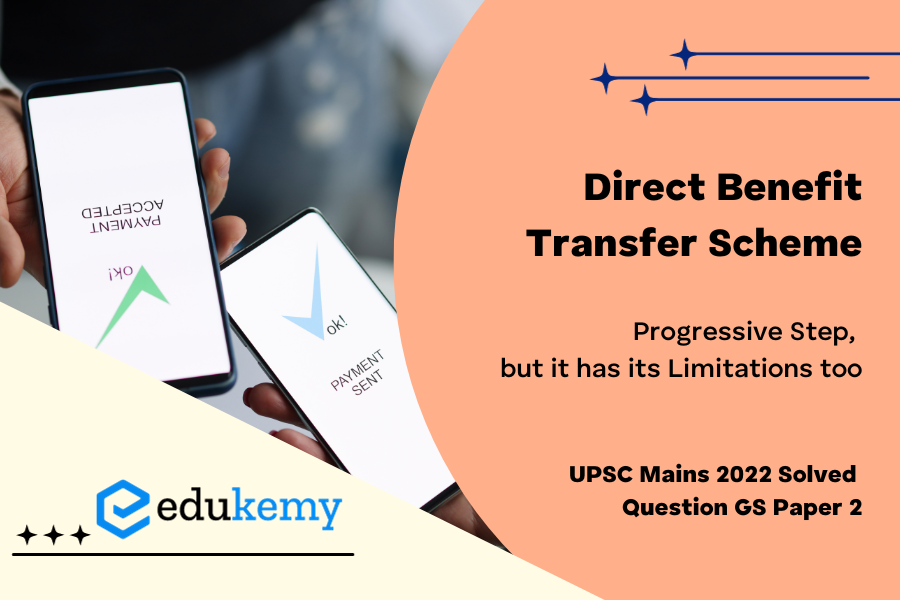UPSC Mains General Studies Paper – 2 Mains 2022
UPSC Mains Civil Services IAS Exam Question Paper – 2022
Theme: Public Service Delivery
Contents
Approach
Introduction: Briefly write about the origin and the purpose of Direct Benefit Transfer Scheme
Body
- Write how the Direct Benefit Transfer Scheme is a progressive step in terms of reforming government delivery system
- Write about the limitations of Direct Benefit Transfer as an instrument of government delivery system
Way Forward: Write down the measures to be taken to make the Direct Benefit Transfer Scheme more effective.
Conclusion: Write down the importance of the Direct Benefit Transfer Scheme in radically transforming the government delivery system in the era of e-governance.
Answer
Introduction
Recently, the International Monetary Fund (IMF) lauded India’s Direct Benefit Transfer (DBT) Scheme as a “logistical marvel” and praised the role of technological innovation in achieving this feat.
The Direct Benefit Transfer (DBT) Scheme was introduced in 2013 to reform the public service delivery system by re-engineering the existing process in welfare schemes. This was aimed at ensuring a simpler and faster flow of funds and ensuring accurate targeting of the beneficiaries, de-duplication, and reduction of fraud.
Body
- DBT Scheme: A progressive step in reforming the government delivery system
- Reduction in leakages: Recently, Prime Minister Narendra Modi stated that the government has saved Rs 2 lakh crore from falling into the “wrong hands” over the last eight years by utilizing modern systems such as Aadhar and mobile through Direct Benefit Transfer.
- Elimination of fraudulent and duplicate beneficiaries: The DBT scheme has brought transparency by making disbursals based on verification of biometric-based Aadhar identity.
- Elimination of Intermediaries: DBT transfer has largely eliminated several middlemen
- in the Public Distribution system who used to get subsidized food grains through fraudulent means and sell it in the open market.
- Timely transfer of Benefits: To streamline fund flow and ensure timely wages, the National Electronic Fund Management System (NeFMS) was implemented in 2016. This has solved the major problem of persistent delay in wage payment under the MGNREGA scheme.
- Effective means of Service delivery: Recently, David Malpass (President of the World Bank Group), has said that India has managed to provide food or cash support to a remarkable 85% of rural households and 69% of urban households during the Covid-19 Pandemic.
Limitations of DBT
- Vulnerabilities of the Aadhaar-enabled payment system: Biometric-based Aadhaar system is not a feasible option to authenticate the work-hardened fingerprints of people working under the MGNREGA scheme and other welfare programs.
- Systematic corruption: Middlemen such as Business correspondents in connivance with bank staff and school staff are cheating poor people. They open accounts of poor people and get the Aadhar-enabled transaction done through their fingerprints. For example, in several districts of Jharkhand, minority students are being duped of a Centrally funded scholarship by a nexus of bank staff, middlemen, school and government employees
- Exclusion Errors: Experts raised concern on the Government’s decision of ending the public distribution system of food grain and give money directly to the people without proper identification of the poor since around 40% are still not officially recognized in India.
- Transaction Failures: During the second quarter of FY 2020- 21, the government processed more than 830 million transactions, and 1.47% of these transactions which means that the large number of beneficiaries did not receive their payments.
- Lack of effective Grievance Redressal mechanism: The current DBT architecture lacks an effective mechanism for customers to resolve grievances like non-receipt of funds or transaction failure.

Way Forward
- Beneficiary-centric Approach: Governments should follow the “Principles of Digital Development.” to include women, persons with disabilities, and other traditionally excluded or vulnerable groups in the design process and the implementation of the scheme,
- Awareness Generation: Despite efforts by the Government, there is low awareness among beneficiaries about their entitlements. Governments should adopt a strategic approach to Awareness, Communication, and Outreach (ACO) programs keeping in mind low levels of literacy among beneficiaries.
- Doorstep delivery of cash benefits: This has been instrumental in providing a safety net to those beneficiaries who cannot travel to access points such as elderly, differently abled and women beneficiaries due to several reasons. Incentivizing Banking Correspondents (BCs) by Union and State Governments by providing them adequate will help in improving last-mile payment delivery.
- Robust Grievance Redressal mechanism: The Government should design a robust beneficiary-centric grievance resolution mechanism to raise grievances and an agency to resolve the grievances related to transaction failure or payment delays
Conclusion
DBT scheme marks a paradigm shift in the process of delivering government benefits to the people which are bringing efficiency, effectiveness, transparency and accountability in the Government system and infusing confidence of citizens in the governance. It is aimed to realize the dream of MAXIMUM GOVERNANCE and MINIMUM GOVERNMENT.
In case you still have your doubts, contact us on 8792740517.
For UPSC Prelims Resources, Click here
For Daily Updates and Study Material:
Join our Telegram Channel – Edukemy for IAS
- 1. Learn through Videos – here
- 2. Be Exam Ready by Practicing Daily MCQs – here
- 3. Daily Newsletter – Get all your Current Affairs Covered – here
- 4. Mains Answer Writing Practice – here


